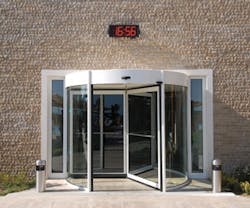Doors and Their Impact on Facility Performance
There are building systems that everyone pays attention to when it comes to improving operating performance (lighting, HVAC, etc.). But some of the less-obvious components of your building can affect operating costs, too, and doors and exterior entrances are some of them. “Exterior doors are a functional part of the building envelope and do have an effect on energy efficiency,” says Dan Depta, manager of marketing at Decatur, MI-based Special-Lite.
According to Evansville, IN-based International Revolving Door Co., every time someone enters or exits through a swing door, approximately 1,800 cubic feet of air also comes in through the doors, thwarting your attempts to efficiently keep indoor air at a comfortable temperature. Doors can also affect operating costs if they don’t seal tightly, take a long time to close, have several vision lights, etc.
To make the most of operating costs when making your next door purchase, Depta recommends that you shop for a door with structural strength, thermal performance, a positive contribution to indoor air quality, and a resistance to corrosion, chemicals, weather, and moisture. “In general, you’re looking for a tightly sealed door that’s lightweight and flexible.”
When shopping for a door, he indicates that the other variables are face sheets and vision lights. “The largest determining factors will be what best matches the aesthetics of the facility and that particular entrance. Hopefully, the choice should come down to aluminum or FRP face sheets because steel and wood aren’t recommended for commercial facilities.”
In facilities where corrosion and rust are dangers, Depta says that an FRP face sheet is essential. “A tightly sealed door is also critical to corrosion protection, as well as mold protection, because it keeps moisture from penetrating the door construction. It’s also critical to energy efficiency, which would be fairly obvious if we were talking about a window or wall, as you need to limit thermal transfer.” He also recommends looking for doors with improved thermal exchange properties and limiting the number of vision lights because glass provides a direct thermal transfer point.
Another consideration in terms of operating costs doesn’t have to do with energy efficiency, but with costs in terms of time, maintenance, and labor. If a door is built to withstand use and abuse, it’s going to require less maintenance and have a longer service life. “In a typical installation, you’re going to have at least one problem door that will need what may seem like constant maintenance,” says Depta. If that’s the case, and staff members are always working on it, that door isn’t helping you at all in terms of minimizing your operating costs.
